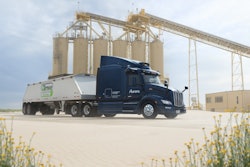Has the pain of high fuel prices led you to change any driving habits – either in your personal transportation or in your trucking operation? The dramatic rise in prices over the past couple of months has taken a financial bite out of highway speedsters. Some have backed off on the accelerator pedal a bit, but probably only temporarily. Old habits die hard.
If your operation is principally severe service, pickup-and-delivery or other local trucking applications, speed may be a negligible issue for you. But for an on-highway operation, speed should be a big deal, perhaps even the No. 1 cost control and risk management priority.
Speed as the top concern? Let’s start with the topic of the day: Fuel prices. The rule of thumb for years has been that for every mile per hour over any set road speed above 55 mph, your truck’s fuel economy will degrade by 0.1 mpg. According to leading fleet managers, that conventional wisdom basically holds true today. So at 70 mph, your fuel economy will be 0.5 mpg lower than at 65 mph. At $3.15 a gallon for diesel, the difference between 6 mpg and 6.5 mpg is a little more than 4 cents a mile. That’s significant for what is really a small difference in speed.
Drivers, of course, don’t see that 5 mph as insignificant. To keep drivers happy at all costs, many fleet owners have been soft on speed for years. They would argue that an intense focus on speed is impractical in a tight labor market.
That’s a cop-out. If the freedom to speed is the difference between a driver staying or going, something is wrong with the driver or with your company. You can’t afford to keep drivers like that because fuel economy is far from the only concern. Don’t forget the wear and tear on components like engines, tires, brakes and drivetrains. Those costs may be difficult to calculate from fleet to fleet, but they are real.
A far bigger worry is the risk speeding invites. First, there’s crash risk. Two of the most costly types of accidents are rear-end collisions and lane-changing crashes. Several years ago, Dayton, Ohio-based Jet Express decided to test the assumption that speeding contributed to the likelihood of being involved in such crashes.
Observing actual operations, Jet Express compared lane changes and brake applications at 65 mph versus 55 mph. At 65 mph, brake applications, which indicate speeding that could lead to a rear-end collision, were higher and on average the number of lane changes doubled. It also stands to reason that the severity of a rear-end collision rises with the speed of the truck at impact.
Jeff Davis, vice president of safety for Jet Express, also points to another risk due to speeding. Many – perhaps most – roadside inspections are triggered by moving violations, he says. More inspections mean more opportunity for violations, and more violations make your company’s trucks a target for more routine inspections at weigh stations. Those inspections also figure into SafeStat, so you are at a higher risk of drawing a compliance review, Davis says. The bottom line is that speeding invites enforcement. Plus, your drivers’ moving violation experience figures significantly into insurers’ risk assessments, so more speeding means higher premiums.
The only plausible argument for driving faster is productivity. In a perfectly efficient transportation system, higher speeds would yield more work with the same drivers and trucks or the same work with fewer drivers and trucks. On long hauls along uncongested highways, speeding might yield measurable productivity benefits.
But often, the benefit is just an illusion. Arriving early for a pickup or delivery is pointless if your driver has to wait until the appointed time. Or drivers might use the time saved for personal business. Layovers instantly erase any time gained. And how might being pulled over for speeding affect your driver’s productivity?
So let your drivers gripe and leave – quickly.








